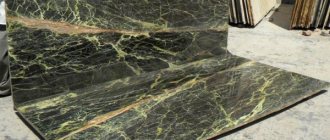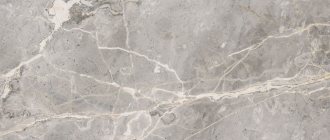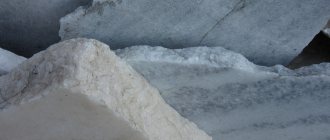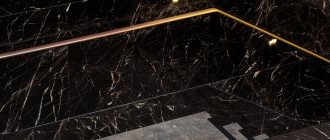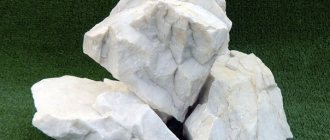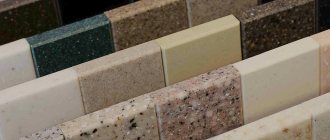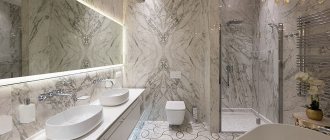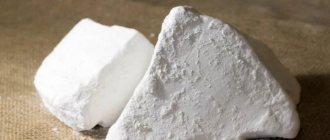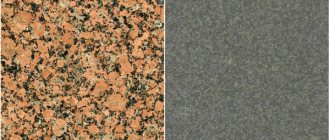White marble is one of the most common types of marble. White marble is quite common in nature and has been mined since ancient times. The most famous deposits are located in Greece and Italy. The most valuable white marble is considered to be pure white marble without veins, but it is extremely rare. The most common marble is white with gray or yellow veins. The veins of marble can form a characteristic pattern, and the color of the marble itself can range from white to white with a gray tint. There is also marble interspersed with pink color. There is also marble interspersed with a golden hue. White marble with a gray tint has less commercial value. High quality stones have a pure white color without veins or with a yellowish tint.
White marble processing and products
Despite its strength, the material is easy to process.
To do this, they use cutters, saws and drills, without fear that the stone will split. Due to the fine-grained, homogeneous structure, even fine carvings are possible on it. And the final polishing gives the finished product a mirror shine. There is no more perfect material for sculpture and sculpture than white marble. After all, only this stone amazingly combines strength and tenderness. Today, sculptors primarily use white stone, although in ancient times a variety of color variations were used. Varieties of white marble are more often used for exterior and interior cladding of buildings. Less often, but you can still find them as pavement flooring. Coarse- and medium-grained types are not recommended for arranging pavements and floors.
As a rule, the marble surface is polished, but it is more advisable to perform fine grinding. Another processing method is bush hammering, which is suitable for large- and medium-grained varieties.
Almost all marble varieties are unstable to atmospheric pollution, this is especially true under conditions of temperature fluctuations or high humidity. White marble contains almost no impurities, which makes it uniform. The fine-grained stone used in sculpture is valued more than others.
White marble is considered a capricious stone due to its structure, which is prone to yellowing and staining. It should be used with caution when cladding facades. The physical and technical characteristics of the material allow it to easily withstand frost and damage, but after time, the surface may lose its shine and beauty and, conversely, acquire yellow spots.
Very often they refuse to use white stone, citing the fact that it is easily soiled and difficult to care for. Despite this, white stone is a kind of standard among other marbles. Possessing high artistic decorative properties, it is very popular among designers and architects.
Another advantage of natural stone is its ability to harmonize well with other materials of any color. The stone fits perfectly into rooms with large footage, where it emphasizes the refined taste of the owners. Most often, white marble is used to decorate columns, steps, stairs, fireplaces and the facade of a building.
The best rooms in the St. Petersburg Hermitage are lined with this stone. Despite the long service life, time has not left its mark on the marble surface and it still emphasizes the luxury and aristocracy of the rooms. The combination with natural wood is considered successful, which achieves the comfort and sophistication of the room. Marble window sills are very popular, emitting a unique shine and gloss.
Marble in the living room interior: design ideas
view album in new window
In the photo: Coffee table with marble top
In the design of the living room, marble is used everywhere: for the tops of coffee tables and cabinets, in the decoration of floors and walls, for the design of stairs and steps, window sills and in decor!
Classic peach and gold living room with a French feel
view album in new window
In the photo: Interior of a finished living room renovation in classicism style
This turnkey apartment renovation option is perfect for anyone who loves the French classicism style in interior design.
Luxurious design of a living room with a kitchen in a niche with gold accents
view album in new window
In the photo: Kitchen-living room renovation in warm chocolate and gold colors
A luxury option with an open-plan kitchen-living room and panoramic views is a renovation from the Fundament group of apartments in the Dolina Setun residential complex. The total area of the apartment is 133 square meters.
Kitchen-living room with a beautiful formal dining room and geometric ceiling
view album in new window
In the photo: Design of a dining room in a living room with luxury finishing
Another three-room apartment in the Setun Valley residential complex, renovated in the Art Deco style from the Fundament Group of Companies! It looks simply great!
Elite living room renovation in shades of gray with complex combined finishing
view album in new window
In the photo: Fashionable living room interior with a formal dining area
In the photo above you see a fashionable interior in the Art Deco style with a complex combination of tiles, marble, mirrors, moldings, with built-in lighting and geometric elements.
Modern living room with fireplace portal and ultramarine curtains
view album in new window
In the photo: Interior of a small living room with designer renovation
A wonderful example of a laconic finish in a modern style for a living room in a new building!
Chic living room in Art Deco style in blue and beige tones
view album in new window
In the photo: An example of a living room design project in cold colors
Here, marble finishing was used for the fireplace portal in blue, which echoes the shades of the upholstery of the sofa group.
White-beige marble
White-beige marble is a variety with a main background of a whitish color with characteristic numerous veins and inclusions of a beige shade with blurred edges and edges.
The largest deposits of beige stone are located in Namibia, where it is mined on an industrial scale. However, its volumes on the world market are extremely small, which determines the high price of the material. The mined monolithic blocks have a variety of sizes: from small to huge. As a rule, the main area of application of beige material is interior decoration.
Photo examples of kitchen and dining room design
view album in new window
In the photo: Kitchen set with a mirrored apron and island
A countertop for a kitchen or kitchen island can be made of different materials: agglomerate and corian (which we discussed above), artificial stone, chipboard and MDF, as well as natural marble. There are countertops made of granite and quartzite, and in the most luxurious projects - from onyx, agate, and labradorite. From floor designs to countertops and backsplashes, white is the most popular color in kitchen design. In the kitchen, the marble pattern can also be found in the design of utensils (on cutting boards, tableware and serving utensils, cups, trays).
Stunning fashionable kitchen with emerald splashback and white cabinetry
view album in new window
In the photo: Kitchen with a green kitchen apron and a light countertop
A stunning design move from an accent kitchen apron in an emerald shade in the form of a diagonal design with boar tiles (herringbone pattern, like French parquet).
Luxurious classic kitchen with designer finishes in warm colors
view album in new window
In the photo: Luxurious kitchen with a chocolate apron and countertop
Classic kitchen renovation with large U-shaped cabinetry and pantry cabinets. On the facades there are relief carved wooden parts in gold and gold handles.
Art Deco dining area in a luxury apartment
view album in new window
In the photo: Beautiful dining room decorated with white and black marble (porcelain tiles) and gold accents
A dining area with a claim to a cinematic level of interior. Art Deco style always looks amazing in an open plan.
Dining room in gray tones with black cupboards and dining area
view album in new window
In the photo: Art Deco dining room in black and gray colors
A wonderful example of understated Art Deco chic for the interior design of a formal dining room for 8 people. On the left is the kitchen with a bar counter, on the right is the living room.
Dining area in a small kitchen in ash-stone tones
view album in new window
In the photo: Dining area in the kitchen in a modern style
And in a small kitchen there is a place for unusual decoration and original design solutions! For example, a panel of lamps in the parametric style.
Massive kitchen with varnished wooden fronts
view album in new window
In the photo: Luxurious kitchen with a large set up to the ceiling
Luxurious kitchen interior with built-in furniture and lacquered facades. The finishing of the floor, countertops and apron imitates natural stone of different types.
How to distinguish from a fake
Some specimens of jasper and quartzite are similar to natural marble, but differ from it in that they do not react with dilute hydrochloric acid and can scratch glass.
Marble furniture, as well as stairs, floors, and house cladding are in demand. To identify fakes, you need to know the physical properties of this stone and the features of its structure.
- There are no voids or plant residues in marble. If air bubbles and organic fossils are visible on the surface, this indicates a imitation.
- It can shine through 30 cm deep .
- The mineral dissolves rapidly in sulfuric acid. You can break off a piece from a purchased but not yet processed stone and treat it with acid.
Artificial marble differs from natural marble in its uniformity of color and pattern, as well as its resistance to acids.
How to care for marble
Marble bath
Marble is plastic and at the same time retains its structure perfectly, so craftsmen can make a lot of interesting things from it. The stone is porous, but has a low level of water absorption, which makes it frost-resistant and allows it to be used outdoors and in places with high humidity. It does not absorb radiation, does not accumulate harmful microorganisms, does not release toxins when heated and is completely safe for humans from an environmental point of view.
Marble is a material that can carry its beauty through centuries, but for this it needs to be properly cared for:
- Do not subject it to various physical loads - the stone is not too hard, it is durable, but a sharp impact may cause it to chip.
- Avoid contact with acids and aggressive chemicals.
- Clean in a timely manner using a soap solution (or special cleaning products) and a soft cloth (abrasives are contraindicated).
- You can protect marble products from dust and other contaminants by applying a special polish rubbed in with suede; white spirit will help get rid of greasy stains; and a very weak chlorine solution will help against fungus and mold.
Magic properties
Many people know what marble is, but not everyone knows that it is powerful as a magical attribute. Meanwhile, in former times, people believed in the magical power of this stone.
In Ancient Greece it was considered a symbol of love. Temples dedicated to Aphrodite, the goddess of love, were built from it. Marble talismans and amulets, according to the Greeks, preserved the feelings of spouses and strengthened their trust in each other.
In ancient Rome, houses were built from marble slabs so that the stone would not allow dark forces and misfortunes into the houses. To protect against evil and black magic, the Romans wore marble amulets.
In India, it was believed that this mineral could communicate with good spirits protecting the home. In India, it still has a special meaning for people. Every family, even the poorest, usually has at least one marble product, since this stone is considered a companion of goodness.
Nowadays, in order to release the magical power of marble, they wear jewelry with it: rings, bracelets, pendants. Figurines protect your home from negative energy.
The stone quickly adapts to the owner’s energy and begins to have a beneficial effect on his life:
- protects from evil people and dangers;
- promotes friendly relationships in the family;
- helps you gain the trust of others and find your true love.
A marble talisman helps maintain harmony and warmth in relationships with a loved one, eliminate jealousy and mistrust, strengthen family ties, and improve relationships among all household members.
If you use the magical power of marble for so-called love spells (attracting love against a person’s will), you can attract not love, but misfortune.
Marble amulets help people whose activities involve danger (for example, military personnel, rescuers, firefighters).
The stone will also help those who work with visitors, protect them from negative energy, and attract the sympathy and trust of others.
The amulet will give sellers and doctors protection from erroneous actions.
Physical and chemical properties
Marble is a rock consisting only of calcite. There are dolomite varieties, when recrystallization of dolomite occurs. The stone can be fine-, medium- and coarse-grained. It is easy to process. Boils violently in hydrochloric acid.
| Formula | CaCO3 (from calcite only) or CaMg(CO3)2 (with dolomite recrystallization) |
| Color | White, black, grey, brown, beige, yellow, red, pink, blue, cyan, green and others |
| Probable impurities | Limonite, manganese, iron, epidote, chlorite, graphite, bitumen, diopside and others. |
| Shine | Appears after polishing |
| Hardness | 25-3 |
| Transparency | Opaque or relatively transparent |
| Strength | Lasting |
| Density | 2.2–2.6 g/cm3 |
| Compression resistance | 500-2500 kg/cm2 |
| Porosity | 0,6-3,5% |
| Abrasion | 0.4-3.2 gm/cm2 |
| Water absorption | 0,15-0,5% |
| Specific gravity | 2,6-2,8 |
Which is better marble or granite
Scientists have gone far ahead in studying transformations unknown to mankind and the nature of the origin of animals on earth. But to find the answer to the formation of minerals, they adhere to one hypothesis. Now it is impossible to answer in monosyllables what is better and worse, stronger and more reliable from minerals. They differ from where they are mined. The place where, over billions of years, they became what they are now.
It is possible to give a figurative explanation. Why is the use of stones in industry and construction different? In many respects, granite is stronger. A monument or artistic stella will look worse from it than from marble. When you need to make a capacious structure that is powerful and durable, then all stones will be inferior in reliability to granite.
For such buildings and structures, the strength of marble is no less than 2 times inferior to the solidity and power of granite.
Which mineral is more expensive? They are no different in price. In appearance, it is not possible to give preference to one of the stones everywhere. The price will also not always prevail for 1 stone over another stone. But there are structures where their advantage emphasizes itself and puts it in 1st place. A fireplace piece or a large vase will look much better even with the dull color of the marble stone. But there are buildings where granite looks much clearer and more elegant
Origin of the mineral and its location
How is marble formed? The origin of marble can be seen from the appearance of chalk, which precipitates. Under the influence of pressure and temperature, as well as due to the strengthening of crystals, a new material appears, formed from smaller particles. It consists of calcite and contains impurities of various minerals and organic compounds, so the chemical formula of marble coincides with the formula of calcium carbonate.
It seems that the rock was formed specifically for mechanical processing by nature itself.
The mineral composition of marble makes it easy to handle turning, sawing and drilling, and its pliability, frost resistance and variety of types allow the stone to be used in a wide variety of fields.
Thanks to these qualities, the mineral is used not only for cladding, but also to create real masterpieces of art. Such material can be embodied in any design shape, size or type.
The mineral composition of marble makes it easy to handle turning, sawing and drilling
We also recommend reading:
The history and curse of the Kohinoor stone The marvelous ametrine stone Characteristics of larimar and its main properties Selection of stones by date of birth
In addition, the rock has a dense structure and sufficient hardness, which is why it does not allow moisture to pass through. Due to this property of marble, there are no microcracks on its surface, and fireplaces made from this material retain excellent heat resistance. The characteristics of marble also include its advantage of being bactericidal, since the mineral has pores that contribute to a good microclimate and less development of bacteria and fungi.
This rock is distributed throughout the world and is mined in various parts of the world.
Stones from Italy, Greece and the USA are especially popular.
Countries where marble is mined:
- Africa.
- Ukraine.
- Georgia.
- Russia.
- Armenia.
- Uzbekistan.
- Kazakhstan.
A significant deposit of marble is located in South Africa.
There are a lot of deposits throughout Russia: in the Urals, Altai, and Western Siberia.
Compatibility with other stones
Marble is a self-sufficient material that does not require combination with other stones, and this is technically difficult to do. Marble products are perfectly combined with wood and metals, both precious and ordinary alloys.
Some skilled craftsmen manage to complement jewelry with various gems, guided mainly by their physical and color compatibility. As for energy compatibility, marble is friendly with all minerals, but most of all with those that belong to the water element.

